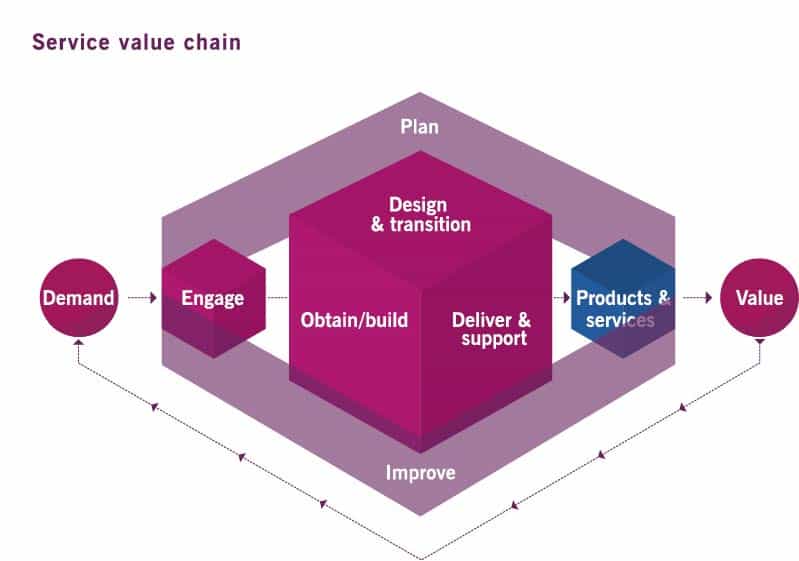ITIL Service Value Chain
Service Value Chain
The Service Value Chain (SVC) is at the center of the ITIL® Service Value System (SVS). It is an operating model that outlines key interconnected activities required to effectively manage products and services.
There are six activities in the Service Value Chain which represent the steps which may be taken in the creation of value. Keep in mind that the activities are not linear. Not all activities will be utilized for every service, and each service may have different orders and/or combinations of these activities.
The six key activities of the IT Service Value Chain are:
- Plan – Ensures understanding of the vision, status, and improvement direction for all Four Dimensions and all products and services.
- Improve – Ensures continual improvement of products, services and practices across all Service Value Chain activities and the Four Dimensions.
- Engage – Provides a good understanding of stakeholder needs, continual engagement with stakeholders, and transparency and good relationships.
- Design & Transition – Ensures products and services continually meet stakeholder expectations for quality, costs, and time to market.
- Obtain/Build – Ensures service components are available when and where they are needed and meet agreed specifications.
- Deliver & Support – Ensures services are delivered and supported according to agreed specifications and stakeholder’s expectations.

Example
This is clear enough, but how does it work in the real world? Restoring a live service is a real-world example of a Service Value Chain map. In this example, the following Service Value Chain activities take place:
- Demand – The customer has a need for his mail service to be restored.
- Engage – The customer engages the Service Desk via the phone. The Service Desk acknowledges and registers the customer’s mail issue in the ticketing system.
- Deliver & Support – The Service Desk agent investigates the issue, identifies it as an Incident and attempts to resolve it.
- Obtain/Build – The Service Desk agent contacts a resolver group who has identified a patch needs to be deployed.
- Design & Transition – The patch is deployed to fix the mail issue.
- Deliver & Support – The Service Desk contacts the customer to verify the incident has been resolved and the mail service has been restored.
- Engage – The Service Desk lead contacts the customer to request feedback on the service interaction he experienced.
- Improve – Improvement opportunities are identified and registered regarding the mail service and the method of contacting the Service Desk.
Mapping the Service Value Chain for each of your key services can be an eye-opening experience. It ensures that critical activities take place as they should, and identifies waste while improving efficiency.
ITIL® is a registered trademark of Axelos Limited, used under permission of Axelos Limited. All rights reserved.
Reuse of any content on this page is strictly forbidden without the consent of ClearBridge Technology Group and Axelos Limited.
We're Here To Help!
Call Us
+1-781-916-2284
